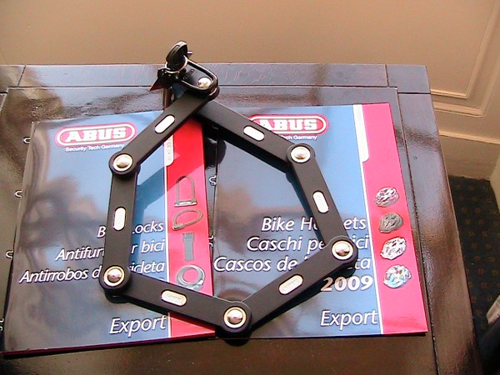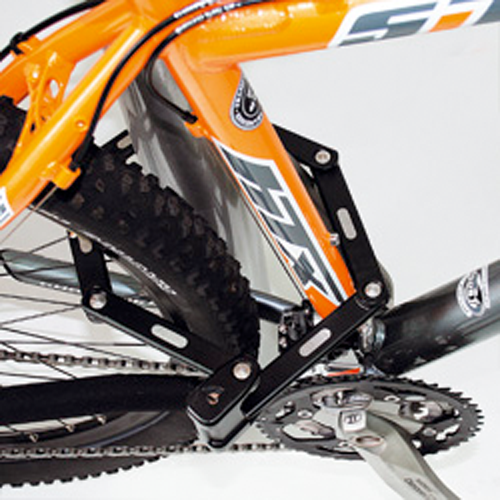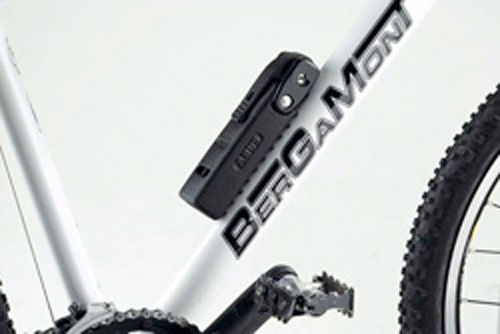
New! ABUS – as the inventor of the U-shackle lock – has once again launched an innovation for bicycle locks: the foldable locks.




above: granit X-plus

above: granit X-plus

above: granit X-plus

above: granit X-plus
Application:
The innovation for all cyclists, whether hobby cyclists or pros.
Protection of two-wheels with a high theft risk
Operation:
Fix your bicycle to a solid object (e.g. lamp post, sign, fence)
Technology:
ABUS X-Plus cylinder for maximum picking protection
Links made from 5.5 mm thick hardened special steel protect against brutal opening methods
Link construction offers maximum flexibility for external securing (i.e. lamp post)
Easy transport thanks to modern bag in stylish design
Compact lock dimensions offer various and simple fixing possibilities at the frame
Transportation:
Handy modern bag protecting against dirt
Producer: Abus

 New York City announced the ten finalists in their bike rack competition. One of these 10 finalists will become the official city bike rack design. Winner’s were to be announced October 24. Who won?
New York City announced the ten finalists in their bike rack competition. One of these 10 finalists will become the official city bike rack design. Winner’s were to be announced October 24. Who won?
Top row, left to right: Next Phase Studios of Boston; Andrew Lang and Henry Dobbs of London; Federico Otero of Lima, Peru. Middle row, left to right: Stephen Jaklitsch Architects of Manhattan; Jeff Miller and Andrea Ruggiero of Manhattan; Baroni & Valeriani Architects of Florence, Italy; Ian Mahaffy and Maarten De Greeve of Copenhagen, Denmark. Bottom row, left to right: Ignacio Ciocchini of Astoria, Queens; Francis Anthony Bitonti/FADarch of Brooklyn; Open Thread Design of Brooklyn.

andrew lang and harry dobbs

baroni valeriani architetti

ian mahaffy and maarten de greeve

jeff miller and andrea ruggiero
After reviewing more than 200 entries from 24 states and 26 countries, a six-member design jury on Tuesday named 10 finalists in the CityRacks Design Competition to create new, better-looking bicycle parking racks.
The winner will be announced on Oct. 24 during National Design Week, an event sponsored by the Smithsonian’s Cooper-Hewitt National Design Museum.
via new york times design addict
NOTE: station north bike rack competition baltimore, deadline november 7, 2008.
SEEN: talking heads, david byrne bike racks

Have been sitting on this post awhile getting into the mood for collapsable concepts and product. Though the “Jackknife” was created in 2006 it was worth posting as the styling and design was noteworthy.


The concept was designed by Philippe Holthuizen and Rodrigo Clavel for a contest sponsored by Cannondale Europe. Both are graduate students of transportation design at the Elisava Design School
in Barcelona.
The pair’s design for an urban bike called the Jackknife was so named because of the way that it folds for easy handling in elevators and on public transportation. Another feature that makes this bike practical for commuting and riding around town is the hydraulic drive system, which stays clean and requires very little maintenance. The design incorporates several features that characterize the Cannondale brand such as oversized tubing, HeadShok front suspension, and a “lefty” monoblade fork.
 >
>
A year later the above photo from Bicycle Design with words from the author. “Just recently, I ran across this picture of the Jackknife prototype from the 2006 Fiets Rai show in Holland. Can anyone who attended the show let me know what was being said about this concept bike? I assume that Cannondale Europe is just using it as a show bike to generate attention, but I am curious if they are actively developing any elements from it. If any of you have heard anything, let me know.”
The following pics are from the Cannondale site with a historical development story inspired by the Jackknife concept…

Heritage: Cannondale Raven II with Lefty fork (1999)

Raven III Urban Concept (2004)

Jan 2006 – ID Dept. starts The Quantum Leap Project Goal: A ridable and fully functional bike inspired by the Jackknife


Frame, Righty Fork, and Case Closed Technology

Sweet looking final Product.

via bicycle design cannondale


Electric/pedal power hybrid bicycles make a lot of sense as commuters. With a small amount of battery power to augment your pedaling efforts, you can achieve extra speed and distance while leaving a minimal environmental footprint and paying next to nothing per kilometer. The Electrobike Pi is a fine example of the state of the art: packed with nifty technology in a design marked by its distinctive arch frame, the Pi is speed limited to 20 mph when powered by the 36V/500 watt electric motor alone.
However, it retails for a whopping $7,500, which could get you a decent second hand family sized sedan that is still running just fine. Well, if you feel that your pockets need a little lightening up while aiming to get some exercise in the process, the Pi electric bike sounds like a pretty good idea. The Pi comes with an aluminum monocoque frame that is constructed from a single piece of made-up metal that shares a similar thickness all over. In terms of electronics, the batteries are of the nickel metal hydride variety and not lithium ion which we have all come to know and love in our fair share of gadgets and gizmos these days. As for the motor, it is a 36V/750 watt brushless DC model that cranks out around 1 horsepower, or 750 watts. Needless to say the final output depends on just how much human power you put in, but I seriously doubt you’ll reach double digits in terms of horses since you’re, well, only human.
The Pi electric bike is currently available from Design Within Reach ( HA! ) and has a maximum speed that registers less than 30 miles per hour. Of course, the bike does hold more power underneath its, er, hood to go faster than that, but you’ll need to get a motorcycle license for that. Each purchase also comes with a designer helmet so you and the Pi will look like one complete entity whenever you take it out for a spin.
The NuVinci planetary gearbox is unique as it changes gear ratios without actually manually switching gears, making it much easier to navigate steeper terrains. Throw in another $1,800 and you’ll be rewarded with a solar charger that further reduces your carbon footprint.
gizmag.com


This Spring PUMA® introduces the PUMA GLOW RIDER, the third edition of the PUMA bike. Possessing the quintessential PUMA characteristics of fun and functionality, the new model distinguishes itself through the unique glow in the dark frame. The bike is part of PUMA Urban Mobility, a collection created with the needs of a city dweller in mind, comprising apparel, accessories and footwear.
The night glow effect paint used on the steel frame of the bike collects the sunrays during the day, and gives this light off when darkness has fallen, in the form of a beautiful glow, lasting for several hours. Remember those night glow stars on your bedroom ceiling when you were small?
With this quirky glowing frame, which asserts higher visibility by night and a unique outer appearance, urban commuters can express their personal style and feel safe at the same time. (more…)


What do these two bikes have in common? Two wheels? We can feel the love.
Designer Roland Kaufmann has gone and built a bicycle out of wood. He calls this cycle Jano, and says it’s a dual bike, equally at home trekking cross-country or taking its rider to and from work every day. This project has gone beyond some vaporware CAD drawing—he’s actually built a great-looking prototype, riding this bike around and impressing everyone in sight. Although Kaufmann never reveals the exact weight of his wooden bike, he extols the virtues of using wood which is pretty innovative. Why wood?
“Did you know that wood is up to 10 times stiffer than fiberglass and nearly 6 times stiffer than a kevlar/epoxy composite? Using wood and epoxy industry created some of the world’s best multi-hulled sailboats, sprint kayaks and rowing shells. lightweights. Quicker in acceleration. Easier in maneuvering. More convenient to carry. Straightforward to maintain and visually divine. A swan among ducks. So why not also using this material for a bike?”
He uses wood veneers glued together into a unique configuration, which he says gives the resulting frame more stability while still reducing its thickness. Cyclists, will this work? Sure looks great, an example of superb craftsmanship.
via GP Designpartners, Treehugger, and gizmodo
 about ron kovach
about ron kovach


































